#some examples of this include but are not limited to:
Explore tagged Tumblr posts
Text
(I've written an essay in the tags so I can as well put it in the reblog)
Cozy game is a very vague term and I think it's mostly an aestetic descriptor that also describes some of the gameplay qualities, like a relaxed pace of the game focused on slow but steady progress and rather forgiving and manageable core mechanics that by default put more emphasis on dilligence than on reflex or strategy.
Of course the relaxing qualities are subjective and You can stress Yourself to death micromanaging and speedrunning Stardew Valley, but by default those mechanics should lead to a more slow-paced, accessible gameplay.
Most of the games I've seen it used for were life SIMs, farming RPGs or slow-paced shop management games with cutesy graphics meaning to evoke relaxed and welcoming atmosphere. Applying the term to any low-poly and/or pixel game regardless of its actual genre mechanics and atmosphere is as weird as claiming that Baldur's Gate 3 is a 'girly game' (also a vague internet-borne descriptor) solely because You can make a pretty character and change the outfits.
It's not to say that there aren't games that expand upon the convention of a cozy game. A good example of a game that's actually playing with a convention of a cozy game is e.g. Graveyard Keeper, which has all the trappings of a slow-paced cutesy farming SIM except it's all made fun of in... quite a morbid way. Mechanically - and to a certain degree aestetically too - it fits the bill. It's very much a slow-paced farming/business management RPG/SIM and it has a really fun stylised top-down pixel artstyle with soft colors. The thematic whiplash is clearly a very intentional subversion of expectations.
Cozy game if used correctly (which it often isn't) is a useful quantifier for people seeking particular qualities of gameplay. It's basically on a same level as 'hardcore' which includes mostly unforgiving games with either a default high difficulty or a very high entry point of mechanics. I've seen it used for soulslikes but also Darkest Dungeon (which is a turn-based roguelike) and even Kingdom Come: Deliverance (historical RPG) due to its limited saves opportunity and challenging fencing mechanics. I think in this case it's also a matter of certain gameplay qualities, which may be influenced by mechanics, genre, or to a certain point, aestetics and atmosphere.
cozy game means fucking nothing. i saw someone call firewatch a cozy game. the game about child death. i saw someone say dredge was a cozy game thats secretly horror. theres nothing secret about the horror the main plot is about necromancy and the world ends. what the fuck are you talking about. is it bc the art style is nice to look at. oh im gonna watch my favorite chick flick the descent. what are you fucking talking about
#game talk#it's definitely not a genre#it IS sometimes used as a marketing term but IMO such usage misses the point#could You make a grim-looking or starkly realistic cozy game?#You probably could but the question is how would it influence the overall atmosphere#It would be a fun challenge for sure
10K notes
·
View notes
Text
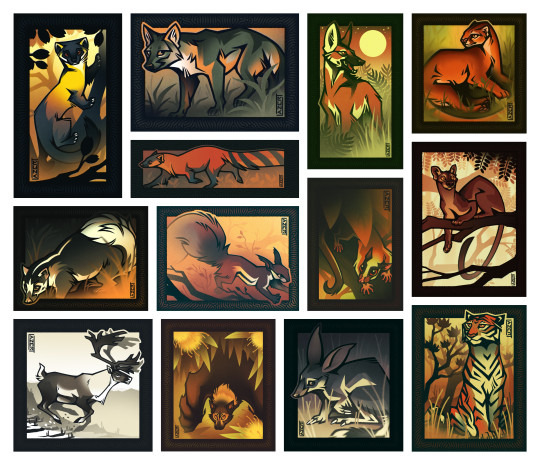
Polls are anonymous so please vote honestly based on what's realistic for you.
More info:
Price may change, but I am currently estimating a price of $70 USD a piece for this style of commission. I understand that this is not affordable for everyone, but currently this is what I can offer based on the time and effort put into these illustrations, and to cover my real life expenses.
The base commission price would include a version with the border+simple background, a transparent version, a square icon version and a circular icon version.
I also intend to include an option to order stickers and/or prints of your commission for an additional cost, which I would physically post to you.
Would be open to working on animal characters, pets, some fictional creatures/spec bio, and also generic real-life species. Would not be interested in working on human or anthro characters, or characters with a lot of complex armor/accessories.
As usual, these won't be first come first serve. There will be limited slots, and I will be choosing projects based on what I think would work best for my art style and feel confident working on.
EDIT: Something I forgot to mention is although all these examples I have are mammals, I am absolutely down to work on birds, reptiles, fish, etc, even invertebrates!
-
I'm not currently open for 3D model commissions, and can't currently give an estimate for when they may reopen. I do eventually intend to do another run of 3D commissions in the future though.
#ignore the inevitable commission scam bots in the comment section - i'll be sniping them as and when i see them lol#poll#not art#commission info#art commissions
147 notes
·
View notes
Text
custom plush dragon info


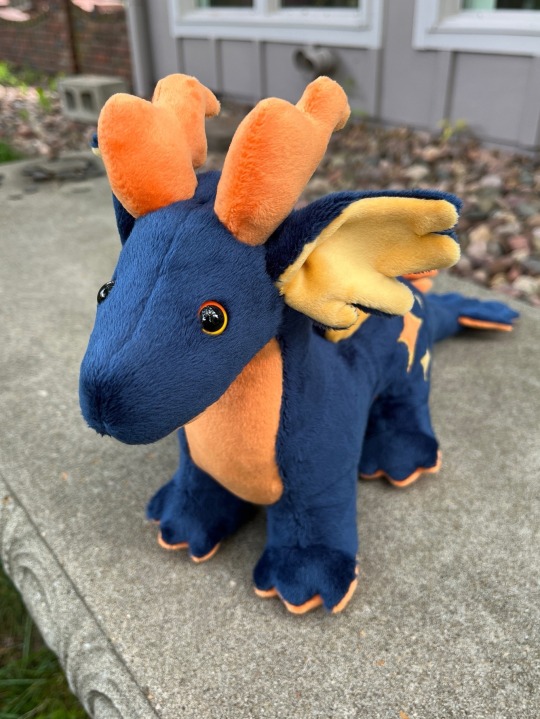
most of this is on my pinned post if you need to find it, but here it is all in one post for your convenience! everything under the cut :)
These dragons are from an original pattern by me, and machine stitched with super soft minky fabric. They are about 14” long (35 cm) and 9” tall (23 cm), depending on how you design them.
They are $60 + shipping, and I ship from the Midwest USA. Shipping is usually around $6-10 in the US, and $15-30 for international, but I'll try to get you the lowest price possible in any case. If you want an estimate, just send me a message! No other commitment required.
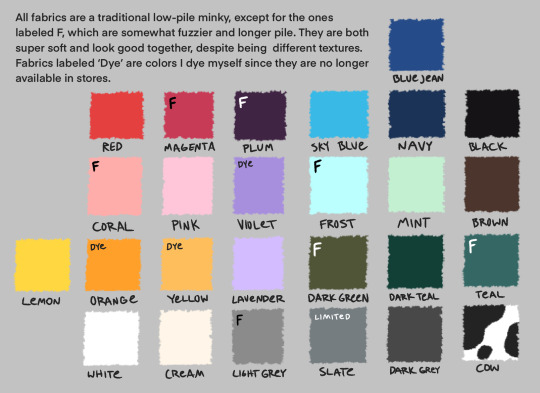
These are the current fabrics I have available. If none of these colors work for you, I can attempt to dye a custom one, but that will take a little more time.
Some colors are in slightly different textures, so be aware of that. They are labelled F, for fuzzy.

For example, this dragon's body & horns are Coral and Magenta, which are fuzzier fabrics. The underbelly and wings are Cream, which is the standard minky. There is a slight difference in texture, but both types are super soft.
[Stuffing note]: I tend to stuff these guys pretty firm to hold their shape, so do let me know if you’d rather have yours be more flopsy.
[Eye color note]: The eyes are plastic safety eyes, and I can do any color you like, including gradients. If you want something very specific, it's good to send a reference I can follow!
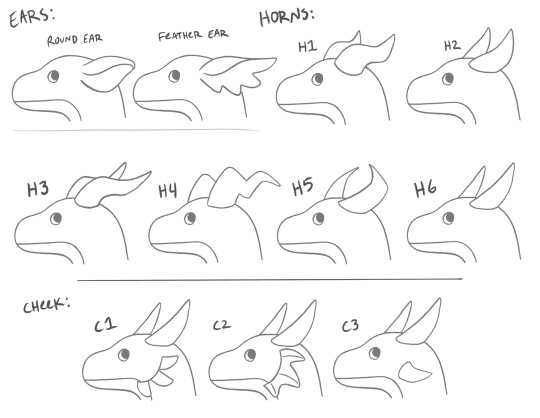
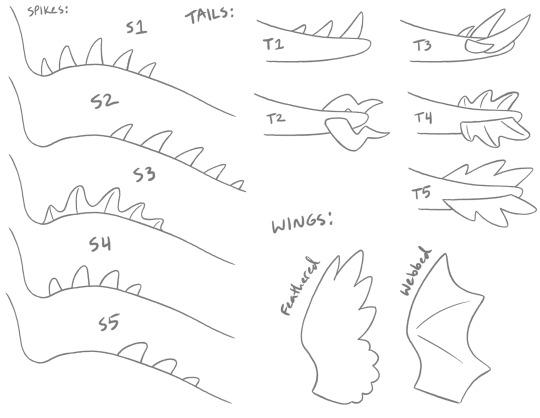
Here are some examples of addons you can choose for your dragon. You're not limited to these, and if you have any references I can use, then I can design some more specific parts.
If you want larger changes to the base pattern (body shape, bigger size, lots of addons, complex embroidery designs, etc.) that will increase the price a bit. Just let me know what you want, and I'll give you a quote!
When you decide on what you want, I will draft you a mockup and make sure you like it before I start to make the dragon. Here is an example of what that might look like:
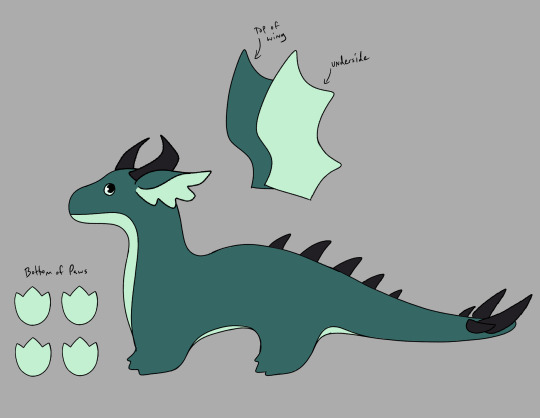
I collect payment at the end, a day or two before the dragon is ready to be shipped. I use Paypal or Venmo.
Feel free to send me a message if you have any questions, or if you want to start working out the details of your dragon! You can also use my order form if that is more convenient for you:
Order Form Here!
Take a look at my plush tag for past dragons I've made!
34 notes
·
View notes
Text
Love and Deepspace LIs if they were in the Riordanverse (Camp Half Blood)
All info on the abilities of demigods pulled from the Riordanverse wiki
While the gods/goddesses might be contentious, I think they go best with the following
Xavier - Hypnos, Rafayel - Apollo, Zayne - Athena, Sylus - Ares, Caleb - Aphrodite
I can see them being Athena, Poseidon, Apollo, Hades, Hermes BUT I think the ones I picked make more sense.
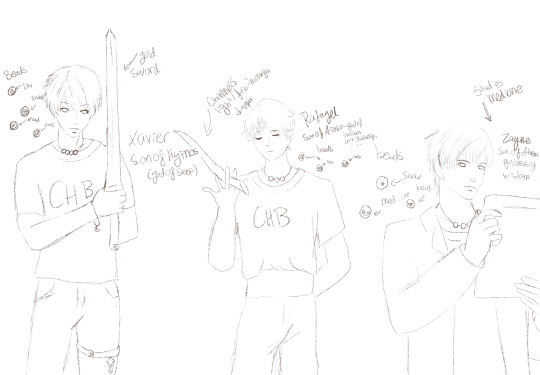
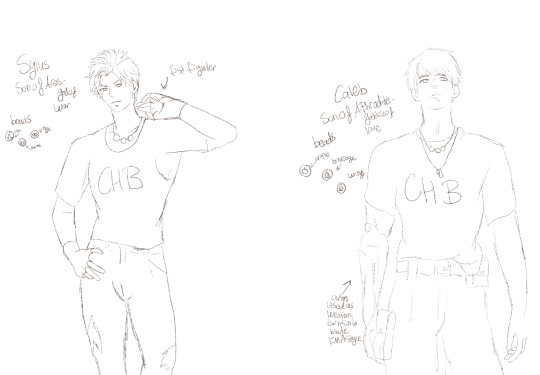
Xavier - son of Hypnos (god of sleep)
Abilities: As a son of Hypnos, he can control sleep and dreams.
He has the ability to astral project in his dreams and in a different form like the gods.
He can see people's memories.
He and his cabin lull people to sleep.
Each of his siblings, including him, radiates individually a power that causes people to fall asleep.
He can do nearly anything involving sleep as his father is the god of sleep.
He can see the gods in his dreams, who always shift forms.
Fights with a golden sword.
Rafayel - son of Apollo (god of music, art, prophecy, the sun, poetry, medicine, etc)
Abilities: He can curse others to only speak in rhyming couplets that can take days or even weeks to wear off (depending on strength and number of people in the spell).
He excels at anything involving throwing or shooting stuff, like shooting hoops or shooting firearms or other missile weapons.
He excels in the arts.
Vitakinesis: As a child of Apollo, he is a natural healers.
He can heal people by singing a hymn to his father (in Ancient Greek).
Audiokinesis: As a child of Apollo, he has the ability to control sound waves and music.
From what can be gleaned from The Demigod Diaries, it can be presumed that some, or even all of Apollo's children possess a limited form of precognition.
Fights with a dagger that harnesses light from the sun to start flames.
Zayne - son of Athena (goddess of wisdom, war, strategy)
Ability: Genius Intellect: children of Athena possess high intelligence and wisdom, especially regarding war strategy.
Craftsmanship: Many of them have instinctive skills in architecture, forging and weaving.
Audiokinesis (limited): They never forget what they heard and can be very manipulative.
Telumkinesis (limited): They adapt to using various types of weapons quicker than normal and develop great control over them.
Enhanced Physical Prowess: They all have enhanced strength, swiftness and durability
He studies medicine and the human body to try to understand disease and surgery. Helps in the infirmary
Sylus - son of Ares (god of war)
Abilities: Telumkinesis: They are able to adapt to using various types of weapons quicker than normal. They have the power to curse their opponents' weapons and transfigure any object into any weapon. Examples include making a sword too heavy to lift properly or turning arrows into rubber, forcibly disarming their opponents.
Odikinesis: They can unconsciously arouse feelings of impulsive anger, hatred, and bloodlust in people, to the point of instigating physical violence.
Necromancy (limited): They can summon the dead of the losing side of a battle.
Enhanced Physical Prowess: They all have enhanced strength and swiftness. The daughters of Ares have the skeletal structure and muscle distribution of exceptionally large, strong, and well-conditioned human men, allowing them to withstand the rigors of combat as well as their brothers.
Intelligence: They are excellent war strategists, though they seem to prefer mindless brute force over strategy like their father.
Fighting skills: They are natural fighters with inborn fighting skills.
Expert fist fighter
Caleb - son of Aphrodite (goddess of love)
Abilities: They have magical control over clothes, makeup, and jewelry.
Amokinesis: As the children of Aphrodite, they have control over feelings related to love and desire.
They have the ability to change their physical features.
Charmspeak: Selected children of Aphrodite can influence other with the strength of their voices. The only known demigods with this ability are Piper McLean and Drew Tanaka. It’s likely it was Silena’s case too, as she uses Charmspeak in the Demigods Files.
They have the ability to speak fluent French and other languages of love.
They possess high social abilities and awareness.
They have the ability to use Permanent Makeup on others, as seen in the Demigod Files
They have the ability to curse people so all of their clothes are two sizes too small for them for a period of time. This is seen in The Demigod Files.
Shapeshifting
Using his rigged metal arm, he can turn it into a blade to fight with
#pjo#pjo hoo toa#love and deepspace#pjo au#lads#Caleb#Sylus#Zayne#Rafayel#Xavier#lads sylus#lads caleb#lads rafayel#lads zayne#lads xavier#grace.png
23 notes
·
View notes
Text
@lilith-hazel-mathematics
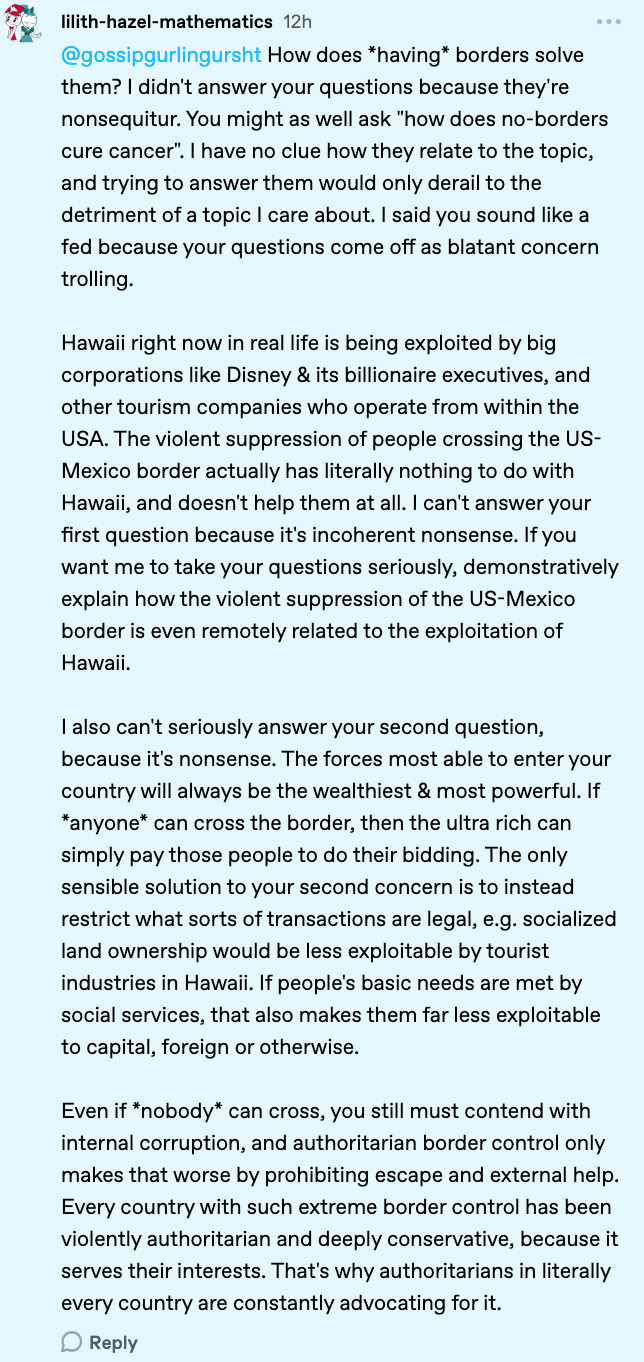
Borders affect the movement of people. They also impact the distribution of political and economic systems. My questions were about the movement of people, and the distribution of economic & political systems. Saying they are non sequitor is willfully obtuse. Almost like you're a fed trying to discredit the no-borders movement by making such aggressive & ignorant replies.
The OP mentions Hawaii as much as it mentions Mexico. None at all. Because those are both specific example cases of borders. The topic of the OP. When discussing high-level topics, it's important to look at real-world examples. That's called supporting evidence.
Here's an example of how to have a conversation: It seems like you're really concerned about the US Mexico border, and the violence being perpetrated there. But if you haven't been following the news lately, the US Republicans' fascist ICE office is violently rounding up anyone, including born US citizens, for looking vaguely brown. Removing the literal US-Mexico border can spread out, or may even reduce violence to some amount. But it doesn't solve racism (the underlying issue here). It also doesn't stop violence against 'foreigners', it just spreads it out.
Having no borders doesn't solve the issue of violence against migrants & asylum seekers. But it does cause additional issues. Like removing one tool that could be used to protect indigenous communities. Saying that borders aren't currently working that way isn't a reason to fundamentally get rid of them, it's a reason to do them better.
You argue that the wealthy can cross any border that isn't under authoritarian control due to corruption and/or capitalism. And then you say "The only sensible solution to your second concern is to instead restrict what sorts of transactions are legal". Ummm, yes? Some transactions should be illegal. That's how laws work, when you're not living in some libertarian hellscape. You're also mixing up emigration & immigration. Restricting the inward movement of non-citizens does not mean restricting the outward movement of citizens. Here's an example: Hawaii (as a hypothetical nation) prevents the purchase of property by non-citizens, and limits renting of property to non-citizens to limited numbers of interested migrants with work skills needed by the country (if any). Citizenship & the right to rent are not to be based on income. The nation also creates limits on development for hotels to limit over-tourism. There is no restriction on emmigration by citizens.
Was that so hard?
Stop Doing Borders
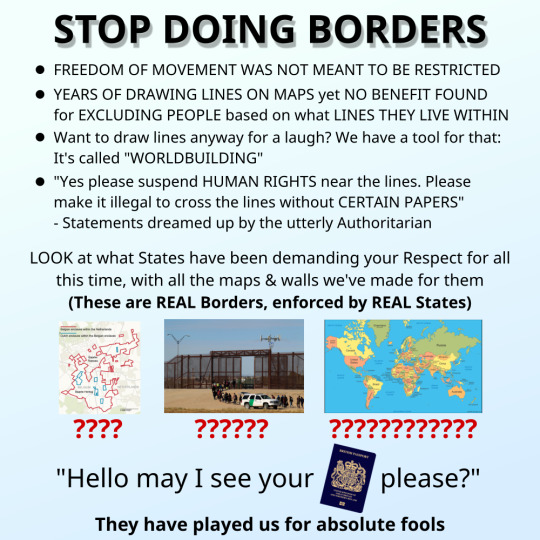

18K notes
·
View notes
Text
Replace Lot and Sim Images in Sims 4 Gallery: Easy Tutorial with Tray Importer
Who says you have to settle for the dull pictures you get in the Sims 4 Gallery? With Tray Importer, you can swap out awkward shots for stylish images that really show off the beauty of your creations and make them stand out in the endless list. Keep reading to learn how to do it quickly and easily!
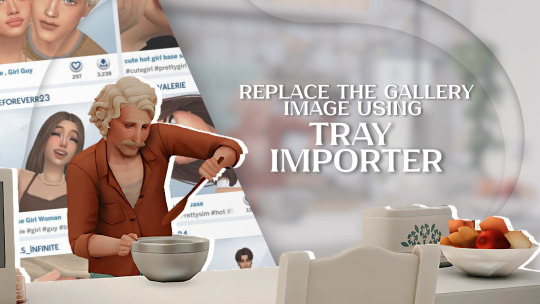
Step 1: Prep in the game itself
1. Save the lot, family, or room to your Library.
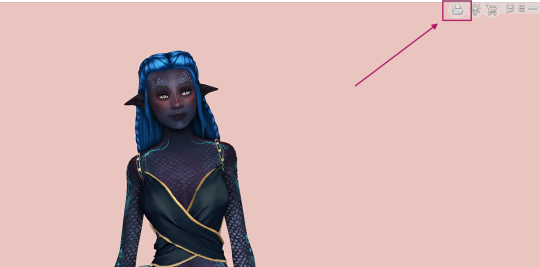
2. Go to the Library, click on the saved item, and see how many images its card contains. You can prepare exactly that many replacement images (if you want to replace them all, of course).
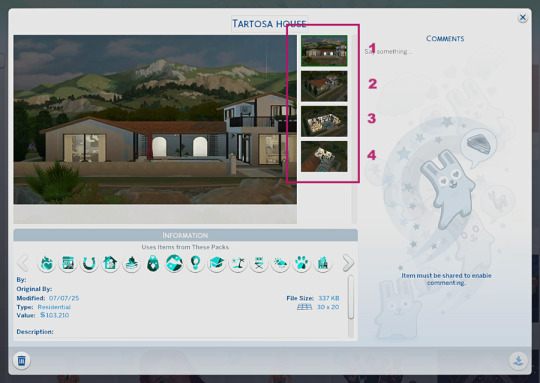
For example, a family card includes: a group family photo and individual photos of each member. If you only want to swap out the preview that shows in the Gallery, just prep one image. If you want to replace everything, add the number of family members to the group photo.
3. The fun part: photos.
Go to the lot or into CAS and take some nice shots for your future replacements (you’ll find lots of helpful tips in our Sims 4 photography guide).
Now you know the maximum number of images you can swap, so keep that in mind and stock up on photos.
Of course, you don’t have to stick to the in-game logic: you don’t need to add a separate shot for each family member – swap everything for cute family moments if you want; you don’t have to snap every floor of the house – focus on the moments with the best vibe. You can put the creator’s name on the preview, or a link to your page… In this case, you’re only limited by the number of images, not their content – get creative :)
4. Save and exit the game.
It’s very important to exit The Sims: otherwise, you won’t be able to replace the images.
Step 2: Launch Tray Importer and select your object
1. Open Sims 4 Tray Importer by Deevo (download at the link).
2. Check in Settings if the path to the root game folder (the one you installed on your computer, not the Documents folder with Mods) is set correctly, as well as the path to the Tray folder.
The Tray path usually looks like:
Documents — Electronic Arts — The Sims 4 — Tray
3. If Tray Importer is working correctly, you’ll see a list on the left of all the objects you’ve saved in your library (lots, families, sims, rooms).
4. Find the needed object by name or using the filters.
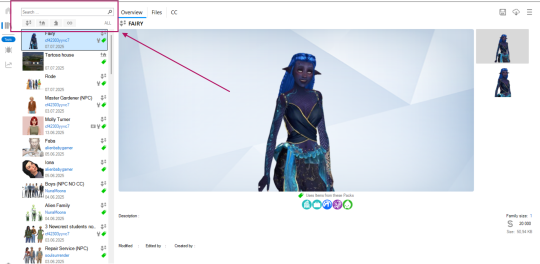
5. Click on it to select.
Step 3: Replacing the image
1. Go to the Files tab.
Here you'll see a list of all the technical files that make up your object. Some of them have embedded images.
2. The file types we're interested in:
For lots – (BPI)
For rooms – (RMI)
For families and Sims – (HHI) and (SGI)
If you click on these files, the images inside them will show up below.
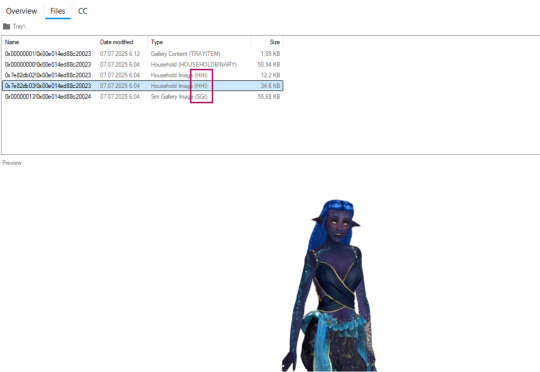
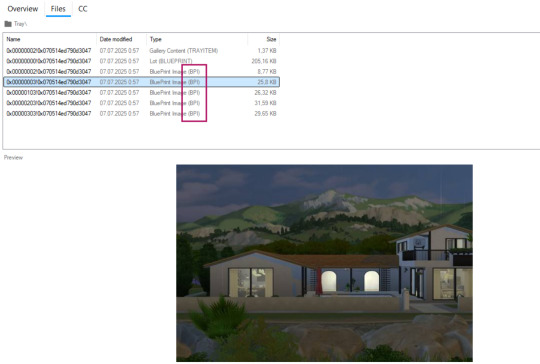
3. Right-click any of the suitable files and select Replace.
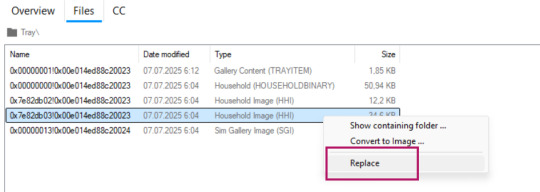
4. In the window that pops up, click on the image you want to replace.
The very first one is the main preview of your object, the one that shows as the thumbnail in the Gallery. It comes in two sizes (you upload your new image once, and it will be used for both automatically).
5. Click Open Image in the top left and upload your prepared file.
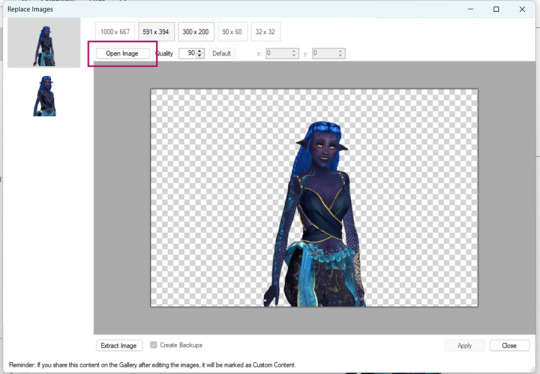
It’s best to use an image in .PNG or .JPG format. The size should be at least 591x394. Don’t worry if your screenshot is much larger than the minimum size – Tray Importer will still ruthlessly compress it.
Repeat this for all the images in the list you want to replace.
6. Save the changes by clicking Apply.
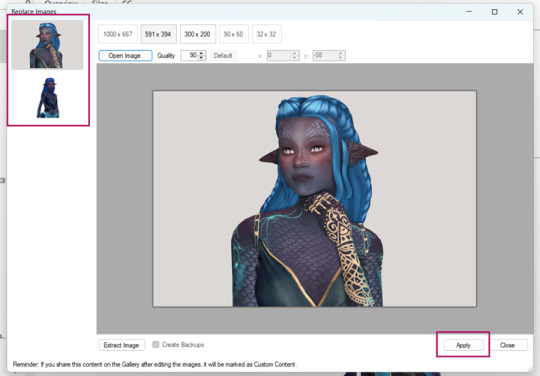
Step 4: Check the changes in-game and publish the object to the Gallery
If the pictures didn’t change, try going through all the steps again or change the format of the files you’re uploading.
Can you replace images after publishing?
If the creation is already published in the Gallery, its card will not change after replacing the image through Tray Importer. You need to remove it from the Gallery and re-upload it for public access.
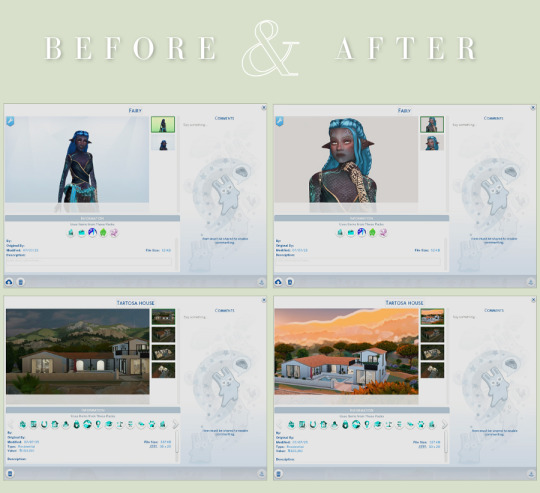
Important! Even if you didn’t use CC when creating Sims or builds, but you changed the images in the Gallery, the game will mark your object as custom content. When recommending someone to download your character from the Gallery, make sure to mention that they need to check the “Include Custom Content” box.
🌱 Create your family tree with TheSimsTree
❓ Support
🌸 Our Blog
#TheSimsTree#simslegacy#legacychallenge#sims 4#sims2#sims3#simsfamily#simstree#sims#sims4legacy#sims4roleplay#sims4stories#thesims4#ts4#ts4cc#plumtreeapp#simsta#simstagram#sims gallery#ts4 mods#sims tray importer#sims override#sims aesthetic
18 notes
·
View notes
Text
A thing I am coming to terms with (and you should too) is that adaptations of media I like will butcher my blorbos. It is inevitable, and it doesn't stop me from enjoying new takes on my favourite things.
Nothing will compare to the highly spacific image of a character I have in my brainmeats, and that's fine. I am enjoying this new and interesting guy who is somehow related to my favourite guy.
Anyway, for healthy media consumption "he wouldn't fucking say that" should coexist with "Huh, I didn't think he would fucking say that, but it kinda rocks."
#this grace does not extend to bbc “sherlock” and “the watch”#random thoughts#media#book adaptation#book tumblr#some spacific example in my case include but aren't limited to#hhgttg#acd canon#the hunger games#epic the musical#dc canon
30 notes
·
View notes
Note
wanna ask how you feel about the eridan bpd headcanon/theory(?? not sure what to call it!) you're so good at your character analysis and i'd love to see your outlook on it
Since I don't have a degree or any formal training in psychology, I feel deeply uncomfortable diagnosing characters. I've made an autism joke before but only because I'm on the spectrum. He's definitely traumatized and anxious, but I mean those as descriptors of his behavior rather than capital-D Diagnoses. I try to focus on those when I can - the cause and effect of cognition, self-image, and behavior - and those factors may very well match up with DSM criteria, but I try not to touch an actual diagnosis with a ten foot pole unless the author has explicitly stated that X character has Y condition.
#there's a variety of reasons for this#part of it is that im GROSSLY unqualified to be handing out diagnoses when it takes a full on PhD to do that in real life#part of it is that psychology is inchoate and we are still very much in murky waters#for example: complex ptsd isn't even IN the DSM yet#and iirc my therapist told me it was because theyre still figuring out how to classify it (attachment disorder? trauma disorder? etc.)#part of it is that (from my limited and undereducated understanding) there are diagnoses that you can assign by completing a checklist...#but some that require a hell of a lot more testing and ruling out other potential causes#and the cluster-b personalities are (IIRC) not even ones you're supposed to diagnose minors with#bc of fears of self fulfilling prophecy and because minors in general are still developing personalities In General#and like the fact that i can't say that with authority speaks to how unqualified i am to do any diagnosing right? hahaha#and part of it is just because like#unless the story is specifically About That and the author has stated so explicitly#i think diagnosing characters tends to put blinders on analysis#like if i were to seriously go 'eridan is autistic' then it would massively bias my reading and understanding of his character#and we have 0 indication that eridan was ever explicitly intended to be autistic or that the author was trying to do an autism specifically#that doesn't mean that the reading is invalid because like thats what death of the author means#all readings are technically valid including stuff the author didn't necessarily intend#but that's just not the way i like to engage with media and not the way i like to approach character analysis#because PERSONALLY it just feels kind of reductive - but also -#i'd wager MOST of us don't have degrees in psychology#so when i say 'X character has Y condition' it might mean something totally different to somebody reading my analysis#even people who have Y condition aren't exempt because a lot of mental illnesses differ from person to person#whereas if i explain “X character has Y thoughts and Z behaviors” there's no ambiguity in that#eridan struggles with noticing that people are suffering and with realizing that he should care#at least part of this is due to his horrific murder-filled upbringing which rendered empathy a detriment & so he learned to ignore it#it could be autism - but it could also be trauma -#or he might just be Like That without actually meeting the diagnostic criteria for autism#& you can't even technically be diagnosed with C-PTSD#or maybe he has a burgeoning personality disorder but you aren't supposed to DX those too early anyway#or maybe hes just 13. see what i mean hahaha. ive reached the 30 tag limit
32 notes
·
View notes
Text
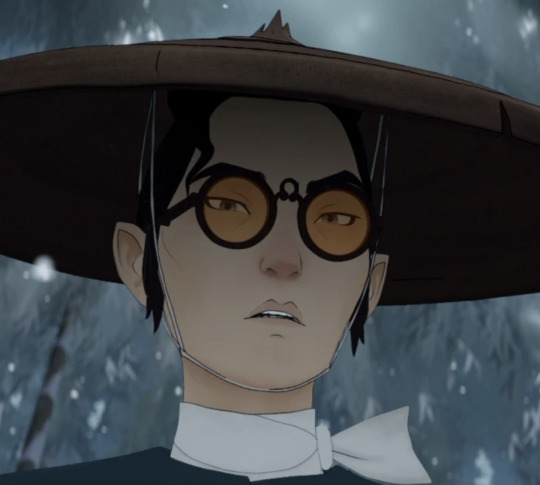
I watched all eight episodes of season 1 of Blue Eye Samurai over the weekend. I then went browsing because I wanted to read some online reviews of the show to see what people were thinking of it and also because I wanted to interact with gifs and art, as the series is visually stunning.
Yet, in my search for opinions on the show, I came across several points I'd like to address in my own words:
Mizu’s history and identity are revealed piece-by-piece and the “peaches” scene with Mizu and Ringo at the lake is intended to be a major character reveal. I think it’s weird that some viewers got angry over other viewers intentionally not gendering Mizu until that reveal, rather than immediately jumping to gender the character as the other characters in the show do. The creators intentionally left Mizu’s gender and sexuality ambiguous (and quite literally wrote in lines to lead audiences to question both) to challenge the viewer’s gut assumption that this lone wolf samurai is a man. That intentional ambiguity will lead to wide and ambiguous interpretations of where Mizu fits in, if Mizu fits in at all. But don't just take my word for this:
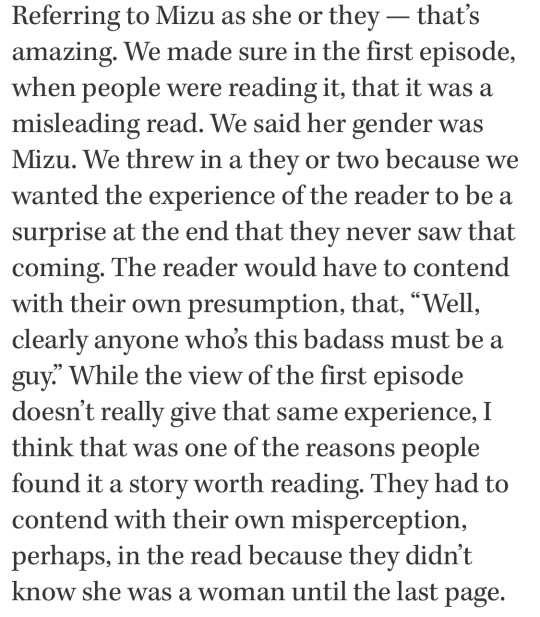
Re: above. I also think it’s weird that some viewers got upset over other viewers continuing to acknowledge that Mizu has a very complicated relationship with her gender, even after that reveal. Canonically, she has a very complicated relationship with her identity. The character is intended to represent liminality in identity, where she’s often between identities in a world of forced binaries that aren’t (widely) socially recognized as binaries. But, again, don’t just take my word for this:
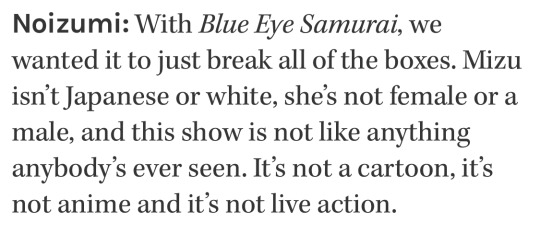
Mizu is both white and Japanese, but she is also not white and not Japanese simultaneously (too white to be Japanese and too Japanese to be white). She’s a woman and a man. She’s a man who’s a woman. She’s also a woman who’s not a woman (yet also not quite a man). But she’s also a woman; the creators said so. Mizu was raised as a boy and grew into a man, yet she was born a girl, and boyhood was imposed upon her. She’s a woman when she’s a man, a man when she’s a man, and a woman when she’s a woman.
Additionally, Mizu straddles the line between human and demon. She’s a human in the sense she’s mortal but a demon in the sense she’s not. She's human yet otherworldly. She's fallible yet greatness. She's both the ronin and the bride, the samurai and the onryō. In short, it’s complicated, and that’s the point. Ignoring that ignores a large part of her internal character struggle and development.
Mizu is intended to represent an “other,” someone who stands outside her society in every way and goes to lengths to hide this “otherness” to get by. Gender is a mask; a tool. She either hides behind a wide-brimmed hat, glasses, and laconic anger, or she hides behind makeup, her dress, and a frown. She fits in nowhere, no matter the identity she assumes. Mizu lives in a very different time period within a very different sociocultural & political system where the concept of gender and the language surrounding it is unlike what we are familiar with in our every-day lives. But, again, don’t just take my word for this:
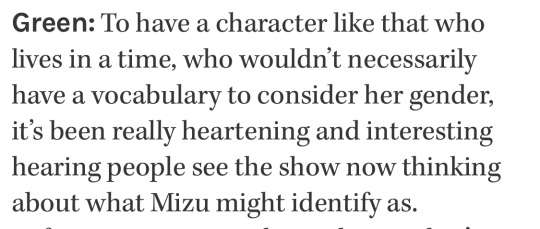
It’s also weird that some viewers have gotten upset over the fact women and queer people (and especially queer women) see themselves in Mizu. Given her complicated relationship with identity under the patriarchy and colonial violence, I think Mizu is a great character for cis-het women and queer folks alike to relate to. Her character is also great for how she breaks the mold on the role of a biracial character in narratives about identity (she’s not some great bridge who will unite everyone). It does not hurt anyone that gender-fluid and nonbinary people see themselves in Mizu's identity and struggle with identity. It does not hurt anyone that lesbians see themselves in the way Mizu expresses her gender. It does not hurt anyone that trans men see themselves in Mizu's relationship with manhood or that trans women can see themselves in Mizu when Mama forces her to be a boy. It's also really cool that cis-het women see themselves in Mizu's struggles to find herself. Those upset over these things are missing critical aspects of Mizu's character and are no different from the other characters in the story. The only time Mizu is herself is when she’s just Mizu (“…her gender was Mizu”), and many of the other characters are unwilling to accept "just Mizu." Accepting her means accepting the complicatedness of her gender.
Being a woman under the patriarchy is complicated and gives women a complicated relationship with their gender and identity. It is dangerous to be a woman. Women face violence for being women. Being someone who challenges sex-prescribed norms and roles under patriarchy also gives someone a complicated relationship with their identity. It is dangerous to usurp gender norms and roles (then combine that with being a woman...). People who challenge the strict boxes they're assigned face violence for existing, too. Being a racial or ethnic minority in a racially homogeneous political system additionally gives someone a complicated relationship with their identity. It is dangerous to be an ethnic minority when the political system is reproduced on your exclusion and otherness. They, too, face violence for the circumstances of their birth. All of these things are true. None of them take away from the other.
Mizu is young-- in her early 20s-- and she has been hurt in deeply affecting ways. She's angry because she's been hurt in so many different ways. She's been hurt by gender violence, like "mama's" misogyny and the situation of her birth (her mother's rape and her near murder as a child), not to mention the violent and dehumanizing treatment of the women around her. She's been hurt by racial violence, like the way she has been tormented and abused since childhood for the way she looks (with people twice trying to kill her for this before adulthood). She's been hurt by state-sanctioned violence as she faces off against the opium, flesh, and black market traders working with white men in contravention of the Shogun's very policies, yet with sanction from the Shogun. She's been hurt by colonial violence, like the circumstances of her birth and the flood of human trafficking and weapons and drug trafficking in her country. She's had men break her bones and knock her down before, but only Fowler sexually differentiated her based on bone density and fracture.
Mizu also straddles the line between victim and murderer.
It seems like Mizu finding her 'feminine' and coming to terms with her 'female side' may be a part of her future character development. Women who feel caged by modern patriarchal systems and alienated from their bodies due to the patriarchy will see themselves in Mizu. They understand a desire for freedom that the narrow archetypes of the patriarchy do not afford them as women, and they see their anger and their desire for freedom in Mizu. This, especially considering that Mizu's development was driven by one of the creators' own experiences with womanhood:
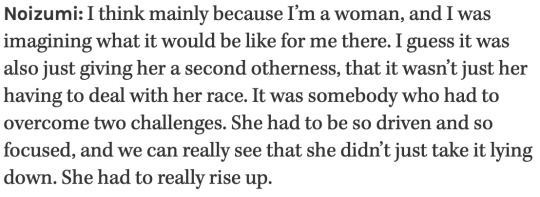
No, Mizu does not pass as a man because she "hates women" or because she hates herself as a woman or being a woman. There are actual on-screen depictions of Mizu's misogyny, like her interactions with Akemi, and dressing like a man is not an instance of this. Mizu shows no discomfort with being a woman or being seen as a woman, especially when she intends to pass herself as and present as a woman. Mizu also shows the women in the series more grace and consideration than any man in the show, in whatever capacity available to her socially and politically, without revealing herself; many of the women have remarked that she is quite unlike other men, and she's okay with that, too.
When she lives on the farm with Mama and Mikio, Mizu shows no discomfort once she acclimates to the new life. But people take this as conclusive evidence of the "only time" she was happy. She was not. This life was also a dance, a performance. The story of her being both the ronin and the onryō revealed to the audience that this lifestyle also requires her to wear a mask and dance, just as the bride does. This mask is makeup, a wedding dress, and submission, and this performance is her gender as a wife. She still understands that she cannot fully be herself and only begins to express happiness and shed her reservation when she believes she is finally safe to be herself. Only to be betrayed. Being a man is her safety, and it is familiar. Being a boy protected her from the white men as a child, and it might protect her heart now.
Mizu shows no discomfort with being known as a woman, except when it potentially threatens her goals (see Ringo and the "peaches" scene). She also shows no discomfort with being known as, seen as, or referred to as a man. As an adult, she seems okay- even familiar- with people assuming she's a man and placing her into the role of a man. Yet, being born a girl who has boyhood violently imposed upon her (she did not choose what mama did to her) is also an incredibly important part of her lived experience. Being forced into boyhood, but growing into a man anyway became part of who she is. But, being a man isn’t just a part of who she became; it’s also expedient for her goals because men and women are ontologically different in her world and the system she lives under.
She's both because she's neither, because- ontologically- she fits nowhere. When other characters point out how "unlike" a man she is, she just shrugs it off, but not in a "well, yeah, because I'm NOT a man" sort of way, but in an "I'm unlike anyone, period," sort of way. She also does not seem offended by Madam Kaji saying that Mizu’s more man than any who have walked through her door.
(Mizu doesn’t even see herself as human, let alone a woman, as so defined by her society. And knowing that creators have stated her future arc is about coming into her “feminine era” or energy, I am actually scared that this show might fall into the trope of “domesticating”/“taming” the independent woman, complete with an allegory that her anger and lack of human-ness [in Mizu’s mind] is a result of a woman having too much “masculine energy” or being masculine in contravention of womanness.)
Some also seem to forget that once Mama and Mikio are dead, no one knows who she is or where she came from. They do not have her background, and they do not know about the bounty on her (who levied the bounty and why has not yet been explained). After their deaths, she could have gone free and started anew somehow. But in that moment, she chose to go back to life as a man and chose to pursue revenge for the circumstances of her birth. Going forward, this identity is no longer imposed upon her by Mama, or a result of erroneous conclusions from local kids and Master Eiji; it was because she wanted people to see her as a man and she was familiar with navigating her world, and thus her future, as a man. And it was because she was angry, too, and only men can act on their anger.
I do think it important to note that Mizu really began to allow herself to be vulnerable and open as a woman, until she was betrayed. The question I've been rattling around is: is this because she began to feel safe for the first time in her life, or is this part of how she sees women ontologically? Because she immediately returns to being a man and emotionally hard following her betrayal. But, she does seem willing to confide in Master Eiji, seek his advice, and convey her anxieties to him.
Being a man also confines Mizu to strict social boxes, and passing herself as a man is also dangerous.
Mizu doesn't suddenly get to do everything and anything she wants because she passes as a man. She has to consider her safety and the danger of her sex being "found out." She must also consider what will draw unnecessary attention to her and distract her from her goals. Many viewers, for example, were indignant that she did not offer to chaperone the mother and daughter and, instead, left them to the cold, only to drop some money at their feet later. The indignity fails consider that while she could bribe herself inside while passing as a man, she could not bribe in two strangers. Mizu is a strange man to that woman and does not necessarily have the social position to advocate for the mother and daughter. She also must consider that causing small social stirs would distract from her goals and draw certain attention to her. Mizu is also on a dangerous and violent quest.
Edo Japan was governed by strict class, age, and gender rules. Those rules applied to men as well as women. Mizu is still expected to act within these strict rules when she's a man. Being a man might allow her to pursue revenge, but she's still expected to put herself forward as a man, and that means following all the specific rules that apply to her class as a samurai, an artisan (or artist), and a man. That wide-brimmed hat, those orange-tinted glasses, and her laconic tendencies are also part of a performance. Being a boy is the first mask she wore and dance she performed, and she was originally (and tragically) forced into it.
Challenging the normative identities of her society does not guarantee her safety. She has limitations because of her "otherness," and the transgression of sex-prescribed roles has often landed people in hot water as opposed to saving them from boiling. Mizu is passing herself off as a man every day of her life at great risk to her. If her sex is "found out" on a larger scale, society won’t resort to or just start treating her as a woman. There are far worse fates than being perceived as a woman, and hers would not simply be a tsk-tsk, slap on the wrist; now you have to wear makeup. Let's not treat being a woman-- even with all the pressures, standards, fears, and risks that come with existing as a woman-- as the worst consequence for being ‘found out’ for transgressing normative identity.
The violence Mizu would face upon being "found out" won’t only be a consequence of being a "girl." Consider not just the fact she is female and “cross-dressing” (outside of theater), but also that she is a racial minority.
I also feel like many cis-het people either ignore or just cannot see the queerness in challenging gender roles (and thus also in stories that revolve around a subversion of sex-prescribed gender). They may not know how queerness-- or "otherness"-- leads to challenging strict social stratifications and binaries nor how challenging them is seen by the larger society as queer ("strange," "suspicious," "unconventional," even "dishonorable," and "fraudulent"), even when "queerness" (as in LGBTQ+) was not yet a concept as we understand it today.
Gender and sexuality- and the language we use to communicate who we are- varies greatly across time and culture. Edo Japan was governed by strict rules on what hairstyles, clothes, and weapons could be worn by which gender, age, and social group, and this was often enshrined in law. There were specific rules about who could have sex with whom and how. These values and rules were distinctly Japanese and would not incorporate Western influences until the late 1800s. Class was one of the most consequential features to define a person's fate in feudal Japan, and gender was quite stratified. This does not mean it's inappropriate for genderqueer people to see themselves in Mizu, nor does this mean that gender-variant identities didn’t exist in Edo Japan.
People in the past did not use the same language we do today to refer to themselves. Example: Alexander The Great did not call himself a "bisexual." We all understand this. However, there is a very weird trend of people using these differences in language and cultures across time to deny aspects of a historical person's life that societies today consider taboo, whether these aspects were considered taboo during that historical time period or not. Same example: people on Twitter complaining that Netflix "made" Alexander The Great "gay," and after people push back and point out that the man did, in fact, love and fuck men, hitting back with "homosexuality wasn't even a word back then" or "modern identity didn't exist back then." Sure, that word did not exist in 300s BCE Macedonia, but that doesn't mean the man didn't love men, nor does that mean that we can't recognize that he'd be considered "queer" by today's standards and language.
Genderqueer, as a word and as the concept is understood today, did not exist in feudal Japan, but the people did and feudal Japan had its own terms and concepts that referred to gender variance. But while the show takes place in Edo Japan, it is a modern adult animation series made by a French studio and two Americans (nationality). Mizu is additionally a fictional character, not a historical figure. She was not created in a vacuum. She was created in the 21st century and co-written by a man who got his start writing for Sex in the City and hails from a country that is in the midst of a giant moral panic about genderqueer/gender-variant people and gender non-conforming people.
This series was created by two Americans (nationality) for an American company. In some parts of that country, there are laws on the book strictly defining the bounds of men and women and dictating what clothes men and women could be prosecuted for wearing. Changes in language and identity over time mean that we can recognize that if Mizu lived in modern Texas, the law would consider her a drag performer, and modern political movements in the show creators' home country would include her under the queer umbrella.
So, yeah, there will also be genderqueer people who see themselves in Mizu, and there will be genderqueer fans who are firm about Mizu being queer to them and in their “headcanons.” The scene setting being Edo Japan, does not negate the modern ideas that influence the show. "Nonbinary didn't exist in Edo Japan" completely ignores that this show was created to explore the liminality of modern racial, gender, class, and normative identities. One of the creators was literally inspired by her own relationship with her biracial identity.
Ultimately, the fact Mizu, at this point in her journey, chooses to present and pass as a man and the fact her presented gender affects relationship dynamics with other characters (see: Taigen) gives this story a queer undertone. And this may have been largely unintentional: "She’s a girl, and he’s a guy, so, of course, they get together," < ignoring how said guy thinks she’s a guy and that she intentionally passes herself as a guy. Audiences ARE going to interpret this as queer because WE don’t live in Edo-era Japan. And I feel like people forget that Mizu can be a woman and the story can still have queer undertones to it at the same time.
#Blue Eye Samurai#‘If I was transported back in time… I’d try to pass myself off as a man for greater freedom.’#^^^ does not consider the intersection of historically queer existence across time with other identities (& the limitations those include)#nor does it consider the danger of such an action#I get it. some come to this conclusion simply because they know how dangerous it is to be a woman throughout history.#but rebuking the normative identities of that time period also puts you at great risk of violence#challenging norms and rules and social & political hierarchies does not make you safer#and it has always been those who exist in the margins of society who have challenged sociocultural systems#it has always been those at greatest risk and who've faced great violence already. like Mizu#Anyway... Mizu is just Mizu#she is gender queer (or gender-variant)#because her relationship with her gender is queer. because she is gender-variant#‘queer’ as a social/political class did not exist. but people WE understand as queer existed in different historical eras#and under different cultural systems#she’s a woman because queer did not exist & ‘woman’ was the sex caste she was born into#she’s also a woman because she conceptualizes herself as so#she is a woman AND she is gender-variant#she quite literally challenges normative identity and is a clear example of what sex non-conforming means#Before the actual. historic Tokugawa shogunate banned women from theater#there were women in the theater who cross-dressed for the theater and played male roles#so I’m also really tired of seeing takes along the lines of: ‘Edo Japan was backwards so cross dressers did’t exist then!’#like. please. be more transparent won’t you?
21 notes
·
View notes
Text
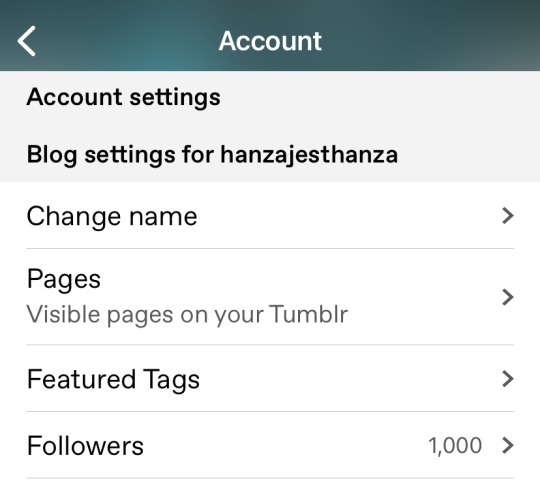

you guys… we did it!!!
just wanted to thank you everyone for being a part of this blog… “big things to come soon”
#i am proud and happy about it because this blog came from my moving blogs in 2021#and on my past blog i had about 1000 followers so it’s like i finally regained that reach#which i’m specifically excited by because this blog (contrary to my previous one) is ONLY about the witcher books with no n*tflix talk#like ik ohhh ‘you are a fandom blog you have no rights’ but it makes me happy that we’re all gathered here together for the same thing :)#i don’t think fandom has to be an inherently toxic or immature space i think it can be a meaningful place of discussion and participation#the elbow-high diaries#updates#it’s kind of an interesting thing the witcher books fandom in english in the 2020s i am really very curious where it goes from here#it’s interesting to me because it’s such a specific and unique situation of media spread#it’s not like the witcher is unpopular or indie—it’s extremely popular. a mass pop culture phenomenon#at the same time the english-speaking (and in my case specifically american) fandom is primarily built around tw3 and then now n*tflix#even if the books were read and successful in the english market i mean they did not have the same kind of cultural impact#so it’s particularly of interest to me to boost visibility and yes indeed—fandom—conversation around the witcher books#and for me i like thinking through what that looks like—#an english-speaking (including not limited to american) fandom without anglifying or americanizing it#or at the very least *trying* to not anglify or americanize it. because some amount of it is unintentional yet necessary (i.e. translation)#but even in translation for example. the kind of translation and how it’s gone about. there is potential for cultural learning and#the most faithful translations will not make total sense so as the readers you go and look for that context and learn something#all part of a larger discussion and i kind of got lost typing these tags but this is why this milestone is special to me#it shows that people are interested in what this blog posts about and that means we have a future to explore
18 notes
·
View notes
Text
"With Donald Trump set to take office after a fear-mongering campaign that reignited concerns about his desire to become a dictator, a reasonable question comes up: Can nonviolent struggle defeat a tyrant?
There are many great resources that answer this question, but the one that’s been on my mind lately is the Global Nonviolent Action Database, or GNAD, built by the Peace Studies department at Swarthmore College. Freely accessible to the public, this database — which launched under my direction in 2011 — contains over 1,400 cases of nonviolent struggle from over a hundred countries, with more cases continually being added by student researchers.
At quick glance, the database details at least 40 cases of dictators who were overthrown by the use of nonviolent struggle, dating back to 1920. These cases — which include some of the largest nations in the world, spanning Europe, Asia, Africa and Latin America — contradict the widespread assumption that a dictator can only be overcome by violence. What’s more, in each of these cases, the dictator had the desire to stay, and possessed violent means for defense. Ultimately, though, they just couldn’t overcome the power of mass nonviolent struggle.
In a number of countries, the dictator had been embedded for years at the time they were pushed out. Egypt’s Hosni Mubarak, for example, had ruled for over 29 years. In the 1990s, citizens usually whispered his name for fear of reprisal. Mubarak legalized a “state of emergency,” which meant censorship, expanded police powers and limits on the news media. Later, he “loosened” his rule, putting only 10 times as many police as the number of protesters at each demonstration.
The GNAD case study describes how Egyptians grew their democracy movement despite repression, and finally won in 2011. However, gaining a measure of freedom doesn’t guarantee keeping it. As Egypt has shown in the years since, continued vigilance is needed, as is pro-active campaigning to deepen the degree of freedom won.
Some countries repeated the feat of nonviolently deposing a ruler: In Chile, the people nonviolently threw out a dictator in 1931 and then deposed a new dictator in 1988. South Koreans also did it twice, once in 1960 and again in 1987. (They also just stopped their current president from seizing dictatorial powers, but that’s not yet in the database.)
In each case people had to act without knowing what the reprisals would be...
It’s striking that in many of the cases I looked at, the movement avoided merely symbolic marches and rallies and instead focused on tactics that impose a cost on the regime. As Donald Trump wrestles to bring the armed forces under his control, for example, I can imagine picketing army recruiting offices with signs, “Don’t join a dictator’s army.”
Another important takeaway: Occasional actions that simply protest a particular policy or egregious action aren’t enough. They may relieve an individual’s conscience for a moment, but, ultimately, episodic actions, even large ones, don’t assert enough power. Over and over, the Global Nonviolent Action Database shows that positive results come from a series of escalating, connected actions called a campaign...
-via Waging Nonviolence, January 8, 2025. Article continues below.
East Germany’s peaceful revolution
When East Germans began their revolt against the German Democratic Republic in 1988, they knew that their dictatorship of 43 years was backed by the Soviet Union, which might stage a deadly invasion. They nevertheless acted for freedom, which they gained and kept.
Researcher Hanna King tells us that East Germans began their successful campaign in January 1988 by taking a traditional annual memorial march and turning it into a full-scale demonstration for human rights and democracy. They followed up by taking advantage of a weekly prayer for peace at a church in Leipzig to organize rallies and protests. Lutheran pastors helped protect the organizers from retaliation and groups in other cities began to stage their own “Monday night demonstrations.”
The few hundred initial protesters quickly became 70,000, then 120,000, then 320,000, all participating in the weekly demonstrations. Organizers published a pamphlet outlining their vision for a unified German democracy and turned it into a petition. Prisoners of conscience began hunger strikes in solidarity.
By November 1988, a million people gathered in East Berlin, chanting, singing and waving banners calling for the dictatorship’s end. The government, hoping to ease the pressure, announced the opening of the border to West Germany. Citizens took sledgehammers to the hated Berlin Wall and broke it down. Political officials resigned to protest the continued rigidity of the ruling party and the party itself disintegrated. By March 1990 — a bit over two years after the campaign was launched — the first multi-party, democratic elections were held.
Students lead the way in Pakistan
In Pakistan, it was university students (rather than religious clerics) who launched the 1968-69 uprising that forced Ayub Khan out of office after his decade as a dictator. Case researcher Aileen Eisenberg tells us that the campaign later required multiple sectors of society to join together to achieve critical mass, especially workers.
It was the students, though, who took the initiative — and the initial risks. In 1968, they declared that the government’s declaration of a “decade of development” was a fraud, protesting nonviolently in major cities. They sang and marched to their own song called “The Decade of Sadness.”
Police opened fire on one of the demonstrations, killing several students. In reaction the movement expanded, in numbers and demands. Boycotts grew, with masses of people refusing to pay the bus and railway fares on the government-run transportation system. Industrial workers joined the movement and practiced encirclement of factories and mills. An escalation of government repression followed, including more killings.
As the campaign expanded from urban to rural parts of Pakistan, the movement’s songs and political theater thrived. Khan responded with more violence, which intensified the determination among a critical mass of Pakistanis that it was time for him to go.
After months of growing direct action met by repressive violence, the army decided its own reputation was being degraded by their orders from the president, and they demanded his resignation. He complied and an election was scheduled for 1970 — the first since Pakistan’s independence in 1947.
Why use nonviolent struggle?
The campaigns in East Germany and Pakistan are typical of all 40 cases in their lack of a pacifist ideology, although some individuals active in the movements had that foundation. What the cases do seem to have in common is that the organizers saw the strategic value of nonviolent action, since they were up against an opponent likely to use violent repression. Their commitment to nonviolence would then rally the masses to their side.
That encourages me. There’s hardly time in the U.S. during Trump’s regime to convert enough people to an ideological commitment to nonviolence, but there is time to persuade people of the strategic value of a nonviolent discipline.
It’s striking that in many of the cases I looked at, the movement avoided merely symbolic marches and rallies and instead focused on tactics that impose a cost on the regime. As Donald Trump wrestles to bring the armed forces under his control, for example, I can imagine picketing army recruiting offices with signs, “Don’t join a dictator’s army.”
Another important takeaway: Occasional actions that simply protest a particular policy or egregious action aren’t enough. They may relieve an individual’s conscience for a moment, but, ultimately, episodic actions, even large ones, don’t assert enough power. Over and over, the Global Nonviolent Action Database shows that positive results come from a series of escalating, connected actions called a campaign — the importance of which is also outlined in my book “How We Win.”
As research seminar students at Swarthmore continue to wade through history finding new cases, they are digging up details on struggles that go beyond democracy. The 1,400 already-published cases include campaigns for furthering environmental justice, racial and economic justice, and more. They are a resource for tactical ideas and strategy considerations, encouraging us to remember that even long-established dictators have been stopped by the power of nonviolent campaigns.
-via Waging Nonviolence, January 8, 2025.
#Chile#Egypt#Germany#Pakistan#Protests#United States#us politics#fuck trump#authoritarianism#revolution#nonviolence#nonviolent resistance#protest#america#protests#democracy#elections#trump administration#good news#hope#hopepunk#hope posting
5K notes
·
View notes
Text
Tesla accused of hacking odometers to weasel out of warranty repairs

I'm on a 20+ city book tour for my new novel PICKS AND SHOVELS. Catch me at NEW ZEALAND'S UNITY BOOKS in AUCKLAND on May 2, and in WELLINGTON on May 3. More tour dates (Pittsburgh, PDX, London, Manchester) here.

A lawsuit filed in February accuses Tesla of remotely altering odometer values on failure-prone cars, in a bid to push these lemons beyond the 50,000 mile warranty limit:
https://www.thestreet.com/automotive/tesla-accused-of-using-sneaky-tactic-to-dodge-car-repairs
The suit was filed by a California driver who bought a used Tesla with 36,772 miles on it. The car's suspension kept failing, necessitating multiple servicings, and that was when the plaintiff noticed that the odometer readings for his identical daily drive were going up by ever-larger increments. This wasn't exactly subtle: he was driving 20 miles per day, but the odometer was clocking 72.35 miles/day. Still, how many of us monitor our daily odometer readings?
In short order, his car's odometer had rolled over the 50k mark and Tesla informed him that they would no longer perform warranty service on his lemon. Right after this happened, the new mileage clocked by his odometer returned to normal. This isn't the only Tesla owner who's noticed this behavior: Tesla subreddits are full of similar complaints:
https://www.reddit.com/r/RealTesla/comments/1ca92nk/is_tesla_inflating_odometer_to_show_more_range/
This isn't Tesla's first dieselgate scandal. In the summer of 2023, the company was caught lying to drivers about its cars' range:
https://pluralistic.net/2023/07/28/edison-not-tesla/#demon-haunted-world
Drivers noticed that they were getting far fewer miles out of their batteries than Tesla had advertised. Naturally, they contacted the company for service on their faulty cars. Tesla then set up an entire fake service operation in Nevada that these calls would be diverted to, called the "diversion team." Drivers with range complaints were put through to the "diverters" who would claim to run "remote diagnostics" on their cars and then assure them the cars were fine. They even installed a special xylophone in the diversion team office that diverters would ring every time they successfully deceived a driver.
These customers were then put in an invisible Tesla service jail. Their Tesla apps were silently altered so that they could no longer book service for their cars for any reason – instead, they'd have to leave a message and wait several days for a callback. The diversion center racked up 2,000 calls/week and diverters were under strict instructions to keep calls under five minutes. Eventually, these diverters were told that they should stop actually performing remote diagnostics on the cars of callers – instead, they'd just pretend to have run the diagnostics and claim no problems were found (so if your car had a potentially dangerous fault, they would falsely claim that it was safe to drive).
Most modern cars have some kind of internet connection, but Tesla goes much further. By design, its cars receive "over-the-air" updates, including updates that are adverse to drivers' interests. For example, if you stop paying the monthly subscription fee that entitles you to use your battery's whole charge, Tesla will send a wireless internet command to your car to restrict your driving to only half of your battery's charge.
This means that your Tesla is designed to follow instructions that you don't want it to follow, and, by design, those instructions can fundamentally alter your car's operating characteristics. For example, if you miss a payment on your Tesla, it can lock its doors and immobilize itself, then, when the repo man arrives, it will honk its horn, flash its lights, back out of its parking spot, and unlock itself so that it can be driven away:
https://tiremeetsroad.com/2021/03/18/tesla-allegedly-remotely-unlocks-model-3-owners-car-uses-smart-summon-to-help-repo-agent/
Some of the ways that your Tesla can be wirelessly downgraded (like disabling your battery) are disclosed at the time of purchase. Others (like locking you out and summoning a repo man) are secret. But whether disclosed or secret, both kinds of downgrade depend on the genuinely bizarre idea that a computer that you own, that is in your possession, can be relied upon to follow orders from the internet even when you don't want it to. This is weird enough when we're talking about a set-top box that won't let you record a TV show – but when we're talking about a computer that you put your body into and race down the road at 80mph inside of, it's frankly terrifying.
Obviously, most people would prefer to have the final say over how their computers work. I mean, maybe you trust the manufacturer's instructions and give your computer blanket permission to obey them, but if the manufacturer (or a hacker pretending to be the manufacturer, or a government who is issuing orders to the manufacturer) starts to do things that are harmful to you (or just piss you off), you want to be able to say to your computer, "OK, from now on, you take orders from me, not them."
In a state of nature, this is how computers work. To make a computer ignore its owner in favor of internet randos, the manufacturer has to build in a bunch of software countermeasures to stop you from reconfiguring or installing software of your choosing on it. And sure, that software might be able to withstand the attempts of normies like you and me to bypass it, but given that we'd all rather have the final say over how our computers work, someone is gonna figure out how to get around that software. I mean, show me a 10-foot fence and I'll show you an 11-foot ladder, right?
To stop that from happening, Congress passed the 1998 Digital Millennium Copyright Act. Despite the word "copyright" appearing in the name of the law, it's not really about defending copyright, it's about defending business models. Under Section 1201 of the DMCA, helping someone bypass a software lock is a felony punishable by a five-year prison sentence and a $500,000 fine (for a first offense). That's true whether or not any copyright infringement takes place.
So if you want to modify your Tesla – say, to prevent the company from cheating your odometer – you have to get around a software lock, and that's a felony. Indeed, if any manufacturer puts a software lock on its product, then any changes that require disabling or bypassing that lock become illegal. That's why you can't just buy reliable third-party printer ink – reverse-engineering the "is this an original HP ink cartridge?" program is a literal crime, even though using non-HP ink in your printer is absolutely not a copyright violation. Jay Freeman calls this effect "felony contempt of business model."
Thus we arrive at this juncture, where every time you use a product or device or service, it might behave in a way that is totally unlike the last time you used it. This is true whether you own, lease or merely interact with a product. The changes can be obvious, or they can be subtle to the point of invisibility. And while manufacturers can confine their "updates" to things that make the product better (for example, patching security vulnerabilities), there's nothing to stop them from using this uninspectable, non-countermandable veto over your devices' functionality to do things that harm you – like fucking with your odometer.
Or, you know, bricking your car. The defunct EV maker Fisker – who boasted that it made "software-based cars" – went bankrupt last year and bricked the entire fleet of unsold cars:
https://pluralistic.net/2024/10/10/software-based-car/#based
I call this ability to modify the underlying functionality of a product or service for every user, every time they use it, "twiddling," and it's a major contributor to enshittification:
https://pluralistic.net/2023/02/19/twiddler/
Enshittification's observable symptoms follow a predictable pattern: first, a company makes things good for its users, while finding ways to lock them in. Then, once it knows the users can't easily leave, the company makes things worse for end-users in order to deliver value to business customers. Once these businesses are locked in, the company siphons value away from them, too, until the product or service is a pile of shit, that we still can't leave:
https://pluralistic.net/2025/02/26/ursula-franklin/#franklinite
Twiddling is key to enshittification: it's the method by which value is shifted from end-users to business customers, and from business customers to the platform. Twiddling is the "switch" in enshittification's series of minute, continuous bait-and-switches. The fact that DMCA 1201 makes it a crime to investigate systems with digital locks makes the modern computerized device a twiddler's playground. Sure, a driver might claim that their odometer is showing bad readings, but they can't dump their car's software and identify the code that is changing the odometer.
This is what I mean by "demon-haunted computers": a computer is "demon-haunted" if it is designed to detect when it is under scrutiny, and, when it senses a hostile observer, it changes its behavior to the innocuous, publicly claimed factory defaults:
https://pluralistic.net/2024/01/18/descartes-delenda-est/#self-destruct-sequence-initiated
But as soon as the observer goes away, the computer returns to its nefarious ways. This is exactly what happened with Dieselgate, when VW used software that detected the test-suite run by government emissions inspectors, and changed the engine's characteristics when it was under their observation. But once the car was back on the road, it once again began emitting toxic gas at levels that killed killed dozens of people and sickened thousands more:
https://www.nytimes.com/2015/09/29/upshot/how-many-deaths-did-volkswagens-deception-cause-in-us.html
Cars are among the most demon-haunted products we use on a daily basis. They are designed from the chassis up to do things that are harmful to their owners, from stealing our location data so it can be sold to data-brokers, to immobilizing themselves if you miss a payment, to downgrading themselves if you stop paying for a "subscription," to ratting out your driving habits to your insurer:
https://pluralistic.net/2023/07/24/rent-to-pwn/#kitt-is-a-demon
These are the "legitimate" ways that cars are computers that ignore their owners' orders in favor of instructions they get from the internet. But once a manufacturer arrogates that power to itself, it is confronted with a tempting smorgasbord of enshittificatory gambits to defraud you, control you, and gaslight you. Now, perhaps you could wield this power wisely, because you are in possession of the normal human ration of moral consideration for others, to say nothing of a sense of shame and a sense of honor.
But while corporations are (legally) people, they are decidedly not human. They are artificial lifeforms, "intellects vast and cool and unsympathetic" (as HG Wells said of the marauding aliens in War of the Worlds):
https://pluralistic.net/2025/04/14/timmy-share/#a-superior-moral-justification-for-selfishness
These alien invaders are busily xenoforming the planet, rendering it unfit for human habitation. Laws that ban reverse-engineering are a devastating weapon that corporations get to use in their bid to subjugate and devour the human race.
The US isn't the only country with a law like Section 1201 of the DMCA. Over the past 25 years, the US Trade Representative has arm-twisted nearly every country in the world into passing laws that are nearly identical to America's own disastrous DMCA. Why did countries agree to pass these laws? Well, because they had to, or the US would impose tariffs on them:
https://pluralistic.net/2025/03/03/friedmanite/#oil-crisis-two-point-oh
The Trump tariffs change everything, including this thing. There is no reason for America's (former) trading partners to continue to enforce the laws it passed to protect Big Tech's right to twiddle their citizens. That goes double for Tesla: rather than merely complaining about Musk's Nazi salutes, countries targeted by the regime he serves could retaliate against him, in a devastating fashion. By abolishing their anticircuvmention laws, countries around the world would legalize jailbreaking Teslas, allowing mechanics to unlock all the subscription features and software upgrades for every Tesla driver, as well as offering their own software mods. Not only would this tank Tesla stock and force Musk to pay back the loans he collateralized with his shares (loans he used to buy Twitter and the US predidency), it would also abolish sleazy gimmicks like hacking drivers' odometers to get out of paying for warranty service:
https://pluralistic.net/2025/03/08/turnabout/#is-fair-play

If you'd like an essay-formatted version of this post to read or share, here's a link to it on pluralistic.net, my surveillance-free, ad-free, tracker-free blog:
https://pluralistic.net/2025/04/15/musklemons/#more-like-edison-amirite

Image: Steve Jurvetson (modified) https://commons.wikimedia.org/wiki/File:Tesla_Model_S_Indoors.jpg
CC BY 2.0 https://creativecommons.org/licenses/by/2.0/deed.en
#pluralistic#tesla#demon-haunted cars#autoenshittification#fraud#odomoter fraud#automotive#dieselgate#elon musk#musk#enshittification#1201#dmca 1201#felony contempt of business model#repair#right to repair
3K notes
·
View notes
Text
I want to talk about why I think this is the one of the most important Falin panels:

So, Falin is really nice, right? It's one of the first things we really learn about her. She's kind even to the monsters of the dungeon - choosing to ward the party rather than fight spirits and cause them needless harm.

In the above early flashback in chapter 11, we see Marcille fawning over Falin's kindness, calling her an angel. Namari calls her soft-hearted. We see Falin choose not to fight even when a zombie attacks - instead she resolves the confrontation with a hug. After the flashback, the first thing Senshi says is that Falin "sounds like quite the person," which Marcille strongly affirms.
At this point in the story, all we have seen of Falin are these impressions; she is a healer, an angel, a caretaker with an infinite well of kindness towards everyone she meets - both friend and foe.
And honestly, that remains most of what we have to go by to understand her. The only times we get to see Falin on the page, alive and just herself, are in the opening and closing pages of the story and in the brief period of time after she is resurrected.
Nonetheless, we do have some more details to work with. For one, there is the scene that The Panel is from - a short memory in chapter 75, when Marcille flashes back to while she's dying. In that scene, Falin prepares to teleport them all out, and says that she's sorry "if there is a person at [their] destination." And that's when we get The Panel.
If you teleport someone or something into another person, the person teleported into is likely to be, at minimum, severely injured. They could die.
We can see a lovely little horrifying example of exactly why in one of the Daydream Hour doodles:
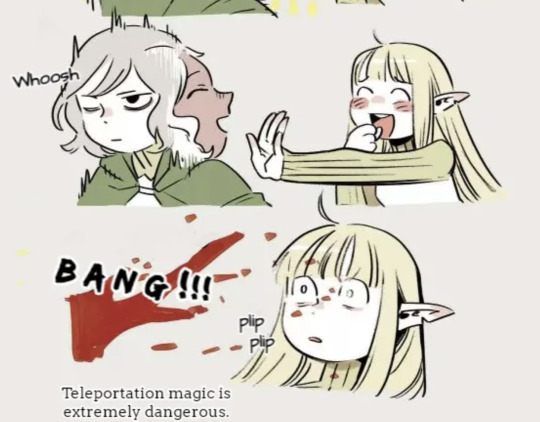
So, hmm. That's not... that's not SUPER nice. Certainly not displaying the same "kindness to all, friend and foe included" we saw represented earlier. On a basic level, this adds some nuance to Falin's kindness. We see it break a little, when pushed to the limit. We see her chose to protect the people she loves above all else.
Which makes sense! As Laios says when the Winged Lion accuses him of similarly being motivated more by his friends' safety than everyone else in the dungeon, "...most people, aside from virtuous do-gooders, would feel the same way."
So, we can take The Panel as simply showing a moment of weakness for Falin. A time when she was pushed to her limits, and that "most people" selfish side of her shone through.
However... I think there's a little more going on with Falin than just her being an angel 99% of the time, except just that once. I love The Panel because I think it helps us understand that Falin isn't just motivated by kindness - she also has a desire to avoid seeing people in pain.
Isn't that the same thing?
No, no it very much is not.
Let's look at a short comic from the Falin section of the Adventurer's Bible, because I think it illustrates this point perfectly. The group is complaining about how much Marcille's healing hurts, and comparing it to Falin's, which "doesn't hurt a bit." Marcille retorts with the following:

Now, the punchline of this comic is that, despite Marcille's sentimental assertion that she's "thinking of [them]" by letting her healing magic hurt, they all still prefer to be healed by Falin.
But hey, this wouldn't be the first time that Dungeon Meshi hides a very real character beat or insight in a gag, so let's think about this somewhat seriously.
If Marcille is right (and she knows a fair bit about magic, so we can assume that she has at least somewhat of a point), then what Falin is doing isn't kind. I suppose if someone specifically requested to not feel the pain, it could be kind, but that's not really what happened here. She is the one who felt badly about the others being in pain, and she is the one who decided, without telling them or giving them a choice in the matter, to take away that pain.
Both Marcille and Falin are healing the party, but Marcille is doing it in a way that accomplishes the task in the most straight forward way, without any additional interference. Falin is going out of her way to perform the healing in a way she is more comfortable with. A way that avoids pain.
Going back the The Panel, I don't think its a coincidence that the only time we see Falin (well, non-chimera Falin) willing to do something that could hurt someone is when any potential pain will be far away from her. If she got someone hurt or killed by teleporting the party to the surface? Not only would it be far out of her sight, but she'd be dead before she had to deal with any consequences of that action.
Falin is not a confrontational person. She doesn't push when Marcille won't tell her the truth about the resurrection, and she comforts Laios about her own death - both of those things happening in the only full chapter she is alive and conscious in the whole story.
We also know that she considered accepting Shuro's proposal, despite not having any special feelings towards him, and that Falin never explained to Marcille that she wanted them to share a meal together. When she brought Marcille various foods at the academy, she just accepted Marcille's confused rejection and gave up.
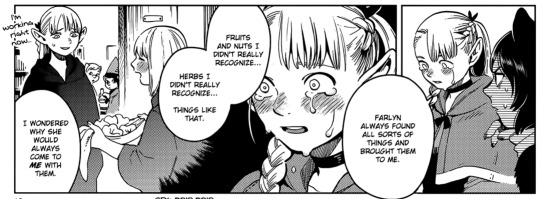
And lastly, we know that she is still in contact with her parents, despite the neglect and abuse she suffered at their hands. Although the way someone chooses to handle contact with abusive or bad family is a complicated topic, which I don't want to overly simplify, I do I think this fact gets at the heart of how she handles conflict.
So many people that Falin loves have hurt her. There are understandable hurts, like Laios leaving the village, or Marcille not understanding the food. And there are bigger, far less justifiable hurts - like her parents neglecting her throughout her childhood, and sending her away to be alone at the magic academy.
It doesn't seem like Falin has ever confronted any of it directly.
And the unhealthy aspects of this kind of avoidance of pain and confrontation is one of the things that the story of Dungeon Meshi is all about. We see Laios grapple with it before he goes to kill Falin, and we see Marcille acknowledge it at the end of the story, when she tells Laios that she has come to terms with Falin's death:
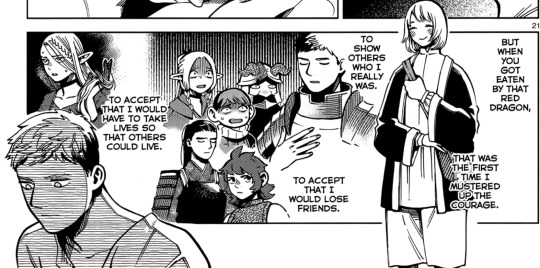

Eating is a part of life. Consuming other living things is a part of life. It isn't really possible to avoid that pain - you can only hide from the truth of it. You have to be selfish everyday. You have to eat - to choose to live. To choose to take up space.
And this is something Falin embraces, too. She comes back to life, after all.
We see her choose to come back to life.
And how does she make that choice? She eats. She consumes, and then she is asked a question by the manifestation of hunger itself:
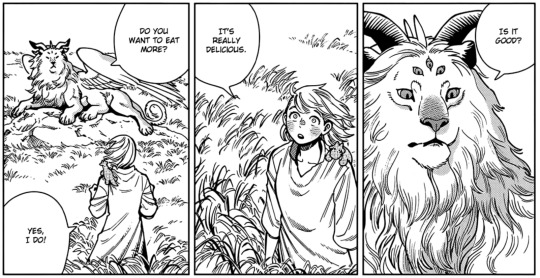
Do you want to eat more?
There is a double meaning in the Winged Lion's final words on the next page.
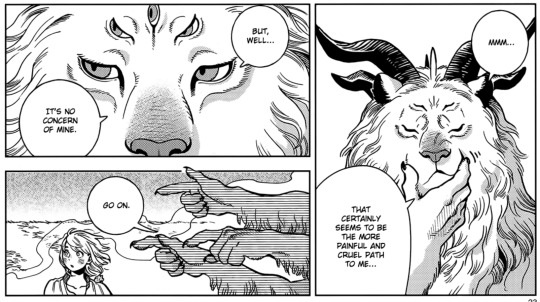
When I first read this, I took it as him saying: life is cruel. You will suffer. You will feel more pain.
But perhaps, especially for Falin, this also means: you are choosing a path where you must cause pain. Where you must consume. Where you must take, and must be selfish. Because eating is the special privilege of the living, and it is their burden, too. In order to stay alive, she will need to keep eating.
And she chooses that. Chooses to be selfish. It's why her resurrection scene is so important, and it's why The Panel is so important. Because Falin coming back isn't the ultimate reward for all of the party's hard work.
It's her choice. Just like it was her choice that started everything in the first place. But this time, she doesn't choose to accept causing pain for the sake of Marcille and Laios. She does it for her own sake.
#dungeon meshi#delicious in dungeon#falin touden#dunmeshi analysis#I love it when dungeon meshi says. the trauma was real and it changed you#and the way you are because of it isn’t anything to be ashamed of#but you have to keep living. you have to chose to keep living.#and you can#dungeon meshi spoilers
16K notes
·
View notes
Text
How I used Psych-k to reprogram my limiting beliefs

꒰ ୨୧ ─ ·┈ · ─ ·┈ ─ ·┈ ─ ·┈ ꒱꒱
What is Psych-k?
͏˚˖𓍢ִ໋☕️ Psych-k is a process which changes subconscious beliefs that limits a person’s potential. It involves reshaping your beliefs into thoughts that can positively impact your life.
͏˚˖𓍢ִ໋☕️ This relates to manifestation because psych-k can help you identify limiting beliefs and reprogram these into thoughts that will benefit you.
꒰ ୨୧ ─ ·┈ · ─ ·┈ ─ ·┈ ─ ·┈ ꒱꒱
Affirmations I used
͏˚˖𓍢ִ໋☕️ Some of the affirmations that I’ve used include:
I let go of every limiting belief I have that no longer serves me
I let go of every doubt I have that no longer serves me
I do not identify with struggle anymore
I’m allowed to believe new things about myself now
Circumstances don’t matter to me, I’ll still manifest anything I want
I manifest instantly
͏˚˖𓍢ִ໋☕️ I do want to mention that a few of these affirmations came from @princessaffirms's why are you DEFENDING your LIMITING beliefs post. It's really insightful and I do recommend reading this if you want more information about limiting beliefs.
꒰ ୨୧ ─ ·┈ · ─ ·┈ ─ ·┈ ─ ·┈ ꒱꒱
My personal experience
͏˚˖𓍢ִ໋☕️ First and foremost, before we go into the psych-k sessions and what to expect, I really recommend you do a test to see where you fall.
͏˚˖𓍢ִ໋☕️ There is many different tests you could do, but me personally I have done the o-ring test. Basically, you form a “O” with your thumb and the other finger, you should use your non-dominant hand with this. Then you would form a ring with your dominant hand and gently pull on the “O-ring.” Then say a limiting belief that you have out loud and do the test.
͏˚˖𓍢ִ໋☕️ Here’s a video that details this -> ☕️
͏˚˖𓍢ִ໋☕️ If it’s a strong response, the ring would not break apart. However, a weak response means the ring would break apart. If you produced a weak response, do this test again and ask your subconscious mind if you can integrate a new belief into them. If you have a weak response, I recommend you write it out using a journal or any writing program like Google Docs or Notes app. Basically with how I did it, I would write down a limiting belief but then I would provide a counterargument for that limiting belief.
͏˚˖𓍢ִ໋☕️ Here's an example: "Manifesting takes forever for me." -> "Manifesting is instant for me."
͏˚˖𓍢ִ໋☕️ Then I would write down all of my limiting beliefs and provide counterarguments for each one. Afterwards, I would do the test again and ask your subconscious mind if you can integrate a new belief. If you get a weak response, keep going and write out limiting beliefs that you have. If you have a strong response, you can test proceed to the session.
͏˚˖𓍢ִ໋☕️ Now here's how I approach my psych-k sessions. First, I would create affirmations that I can use, these affirmations will basically be what you use during your sessions. Then I would record these affirmations using the Parrot app. Although I primarily use the Parrot app, you can also say these affirmations out loud. Then afterwards, I would find somewhere that is calm and you know there wouldn't be any distractions. Next, establish a position you would use, I personally did this position (here) but I crossed my legs instead of my ankles. I would want to add that you should do all 4 combinations to reach all the different parts of the brain. Then set a time limit, I personally reach for 5 minutes per combination but you can do more than that if you choose. Then after setting a time limit, I would start the session, whether that's looping your affirmations on Parrot or say them out loud.
͏˚˖𓍢ִ໋☕️ After the session, First I would do this, that way you are saving the belief, Then I would do the O-ring test again and move on with your day. Now even with one session, you can produce a strong response, but you can do more sessions to solidify your beliefs if you choose to.
͏˚˖𓍢ִ໋☕️ In my experience, after doing this, I noticed that manifestation wasn't a struggle for me anymore. I allowed myself to integrate this new belief into my subconscious mind and ever since I have gotten amazing results. So, please if you want to reprogram your beliefs, try this out and you will never look back!
꒰ ୨୧ ─ ·┈ · ─ ·┈ ─ ·┈ ─ ·┈ ꒱꒱
Resources I’ve used
͏˚˖𓍢ִ໋☕️ Here is some resources I've personally used when starting my journey.
͏˚˖𓍢ִ໋☕️ Rewire Your Brain: PSYCH K Explained
͏˚˖𓍢ִ໋☕️ PSYCH-K by @chaisshitposts
͏˚˖𓍢ִ໋☕️ 4 MINTUE Reprogramming of the 'SUBCONSCIOUS MIND"
꒰ ୨୧ ─ ·┈ · ─ ·┈ ─ ·┈ ─ ·┈ ꒱꒱
#psych k#psych-k#manifestation#loablr#loa tumblr#loa blog#master manifestor#loa success#law of assumption#loassumption#subliminals#limiting beliefs#c1nnamxniris
1K notes
·
View notes
Note
Hi Sinister, I dont know if this is true or not, but I dont thinka o3 is for fanart, i think they explicity put out a thing recently saying they were cracking down on art in stuff because it wasnt plain writing. I could be wrong though
Hey pal! <3 I'm excited to tell you that you've been misinformed!
AO3 is not a fanfiction site, it's a fan works site. All non "ephemeral" fanworks are explicitly allowed, including fanfiction, fanart, animations, amvs, and fanish non-fiction of all kinds.
What they're cracking down on is *non fanworks* that is, posts that aren't fanworks, such as placeholder fics, lists of prompts, etc.
here's an excerpt from the news post they put up recently about the crackdown:
-
AO3 is an archive for fanworks, not other kinds of content.
AO3 has a very specific purpose: to host fanworks, and only fanworks. Our definition of "fanwork" is broad: fanworks can take many shapes and forms, including fanfiction, fanart, podfics, fanvids, fancrafts, fannish non-fiction, original works, and more.
What are some examples of non-fanworks?
Works that are not fanworks should not be posted to AO3. These include (but are not limited to):
Fic searches or requests for recommendations
Advertisements for roleplay partners or servers
Personal messages to other users
Updates, polls, or announcements
Reaction, blog, or vent posts
Spam, shitposts, or memes
Reposted novels or other published works
Placeholders and other empty works
Links to or lists of works you've read or created
Ideas or prompts for fanworks
Requests for other users to provide you with ideas or prompts for fanworks
#archive of our own#ao3#fanfiction#fanfic#fan fiction#art#fanart#fan art#fanworks#fandom history#🔍⚔️
1K notes
·
View notes
Text
Writing Tip - How To Make Fight Scenes Interesting
More writing tips
So, when it comes to writing fight scenes, as I have done quite a few of them, there's some things I keep in mind.
Ensure Consistent Character Abilities: Characters should fight consistently throughout the scene. They shouldn’t magically become stronger or weaker without a clear reason. Consistency in their abilities helps maintain believability.
Avoid Making Heroes Invincible: I prefer not to portray heroes as invulnerable, as seen in many 80s action movies. Instead, I include moments where the hero gets hit, shows visible injuries, and shows fatigue. This makes them feel more human and improves the significance of their victories. It’s hard to create a sense of urgency if the characters don’t seem to be in real danger.
Portray Antagonists as Competent: I avoid depicting random cannon fodder as foolish by having them attack one at a time or easily get knocked out. Instead, I show them employing smart tactics such as ganging up on the hero and even getting back up after being knocked down.
Incorporate the Environment: Don’t forget to include the surroundings. Whether the fight takes place in a cramped alley, on a rain-soaked rooftop, or in a collapsing building, use the environment creatively. Characters can use objects as weapons, find cover, or struggle against challenging terrain.
Highlight Self-Inflicted Pain: Characters can hurt themselves just as much as their opponents. For instance, after landing a powerful right hook, a character might need to pause and shake off their hand in pain. This not only adds realism but also highlights the toll that fighting takes on the body.
Show Consequences After the Fight: Consider what happens after the battle concludes. Do injuries slow the hero down and limit their abilities for the rest of the story?
These are just a few tips for now. I am planning to release more tips on how I write my fight scenes with some examples included. See you then!
#creative writers#creative writing#fanfic review#fanfiction#fanfiction tips#helping writers#how to write#references for writers#review tips#wingfic#writer#writers#writers and poets#writers community#writers corner#writers on tumblr#writing#writing advice#writing community#writing help#writing inspiration#writing life#writing prompts#writing resources#writing tips#writing tips and tricks#resources for writers
2K notes
·
View notes